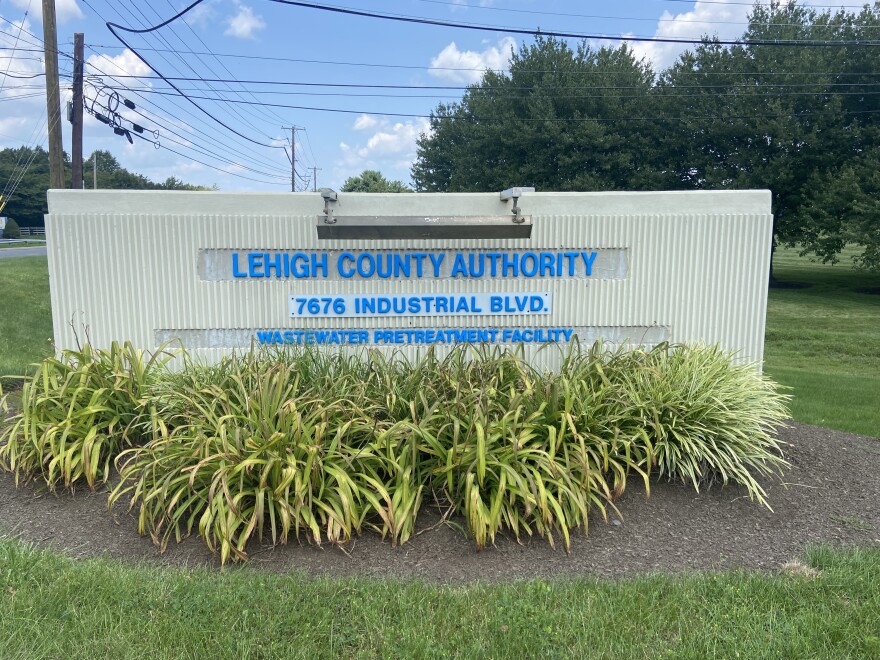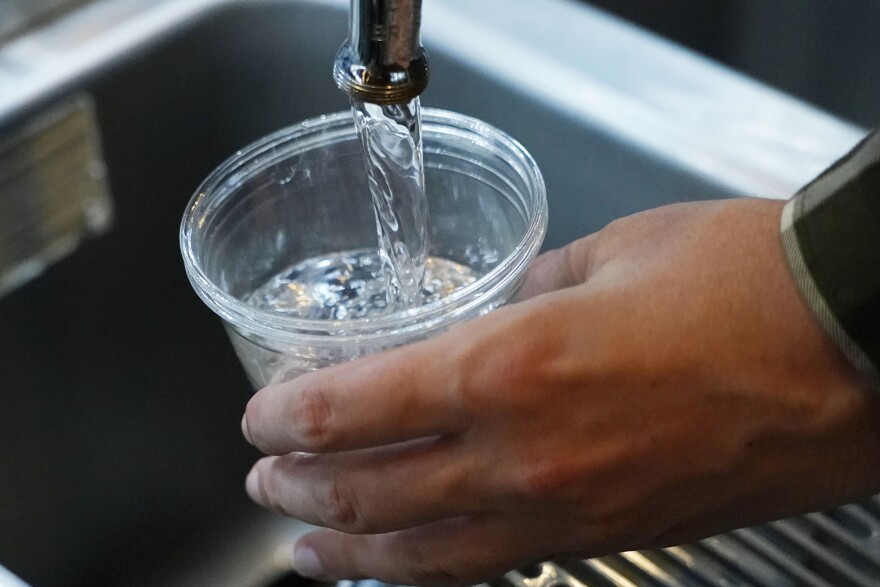LOWER MACUNGIE TWP., Pa. — The Lehigh County Authority has a map on its website, speckled with blue squares, red circles, yellow triangles and gray diamonds.
Red circles denote lead pipes, while yellow triangles signify those made of galvanized steel. Gray diamonds mean the material the pipes are made from is unknown, while blue squares indicate non-lead pipes.
“LCA provides water service to customers in 13 municipalities,” said Liesel Gross, the CEO of the nonprofit water and wastewater utility. “… We have notices going out to customers in all 13 of those municipalities indicating where there are lead, galvanized or unknown service lines.”
It’s going to cost an estimated $100 million over the next decade to replace pipes made of lead, galvanized steel and unknown materials throughout the Lehigh County Authority’s service area, officials said.
The impact on customer rates remains to be seen.
To meet regulatory requirements from the Environmental Protection Agency, including new guidelines released last month, the authority is sending almost 40,000 letters to residents in its service area, including Allentown.
In addition to notifying residents the service lines bringing water to their homes are made of materials that most likely need to be replaced, the letters also outline the risks of lead exposure and how residents can test their water.
By the end of this week, the authority will have sent out letters to 39,683 customers. That includes 4,703 with lead service lines, another 6,115 with galvanized service lines and a whopping 28,865 with service lines made of unknown material.
EPA rules, regulations
Pennsylvania, including the Lehigh Valley, has a lead pipe problem.
Last year, the commonwealth ranked fourth out of all U.S. states for the most lead pipes, according to the Environmental Protection Agency’s “7th Drinking Water Infrastructure Needs Survey and Assessment.” Florida, Illinois and Ohio were the only states to rank higher.
In total, Pennsylvania has about 689,000 lead service lines, making up 7.5% of all service lines in the commonwealth, according to results of the EPA's survey.
Exposure to lead — which cannot be seen, tasted or smelled in drinking water — can build up over time, causing a range of health effects, according to the Mayo Clinic.
In children, lead poisoning can cause a developmental delay, learning difficulties, irritability, loss of appetite, weight loss, sluggishness and fatigue, abdominal pain, vomiting, constipation, hearing loss, seizures and eating things, such as paint chips, that aren't food, according to the medical center.
While the Environmental Protection Agency’s action level for lead contamination is 15 ppb or parts per billion, the agency has “set the maximum contaminant level goal for lead in drinking water at zero.”
In the past half-decade, the EPA has twice updated its guidance around lead pipe replacement as well as how and when water authorities, like the LCA, should notify residents.
EPA officials in 2021 finalized their Lead & Copper Rule Revisions, 30 years after the original was enacted in 1991. As part of the regulations, utilities were tasked with completing an inventory of all water service lines to include the material the pipes are made of.
Many systems, including LCA, do not have full or complete records of the service line material, so an ‘unknown’ service line material is a very common result of this process.Liesel Gross, Lehigh County Authority CEO
“Many systems, including LCA, do not have full or complete records of the service line material, so an ‘unknown’ service line material is a very common result of this process,” Gross said.
Systems are also required to publish a customer portal, which is up and running on the LCA’s website. With it, residents could look up their addresses and learn about their service line material. In addition, utilities must directly notify customers via mail if their service line is made of lead, galvanized, or an unknown material.
The EPA gave utilities until Oct. 16, 2024, to comply.
Notification includes a 30-day grace period, Gross said, adding, “So we are sending letters out in batches, with the final set going out this week.”
However, in mid-October, the EPA published a new rule, the Lead & Copper Rule Improvements, or LCRI.
The key change? Utilities now have a deadline — 10 years — to remove all lead service lines from the system.
“The LCRR required utilities to have a replacement program, but did not establish a clear deadline for complete removal of lead service lines,” Gross said. “The LCRI, on the other hand, includes a 10-year deadline to remove all lead service lines from the system.
“This includes service lines made of lead, galvanized iron or steel requiring replacement, or unknown service lines.”
A major part of the work includes identifying what material makes up “unknown” service lines. If it isn’t made of lead or galvanized material, then it doesn’t need to be replaced, lessening the final cost.
“But the process of identifying the material of 28,865 service lines will take several years to complete,” she said. “I should also note that while the LCRI provides for a 10-year replacement window, there is also a 3-year compliance period, so utilities actually have 13 years to do the work if they start right away like LCA is trying to do.”

Testing available
The letters to residents, available in both English and Spanish, all start the same, with the property’s address included directly above the notification type: “notice of unknown service line material,” “notice of confirmed galvanized service line” or “notice of confirmed lead service line.”
“Lehigh County Authority’s (LCA) mission is to protect public health and the environment by providing high-quality, safe and reliable water and wastewater services,” officials said next in each letter. “The drinking water from LCA’s water sources (creeks, springs and wells) is lead-free.
“However, water service lines connecting properties to the water main in the street may be made of lead, increasing the risk of lead leaching into drinking water.”
In addition to information about the health effects of lead in drinking water, the letters also include how residents can lessen their exposure.
Residents can also bring their letter to the authority’s Customer Care location in Allentown to pick up a water sampling test kit.
"As LCA is developing the lead service line replacement program, we will be working in phases and applying for grants to help defray the cost."Liesel Gross, Lehigh County Authority
“As LCA is developing the lead service line replacement program, we will be working in phases and applying for grants to help defray the cost,” Gross said. “Customers included in each phase will receive direct notification from LCA as we enter each neighborhood with this program.”
Last month, state legislators announced theLCA was awarded $12 million to replace 1,000 private lead service lines in Allentown.
Just under half that money is in the form of a low-interest — 1% — 30-year loan from Pennvest, a state agency that provides capital funding for drinking water. About $6.4 million doesn’t have to be repaid.
While the award announcement and the letter to residents were sent around the same time, it’s a coincidence, Gross said, adding it’s “really a separate issue.”
“The project that we received funding for is for a specific set of 1,000 lead service lines that we hope to complete in the next 12 months, and we will be communicating directly with customers included in this project,” she said.
This effort is also separate from the LCA's $300M wastewater plan to overhaul and upgrade aging water and wastewater infrastructure across more than a dozen Lehigh County municipalities, also over the next decade.
For more information, go to the Lehigh County Authority’s website.


